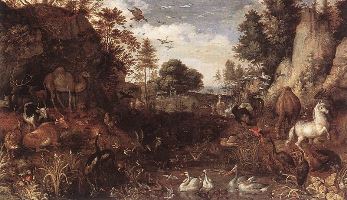SCIENCE & TECHNOLOGY
The Age of the Earth
Part 10: The Garden of Eden
By Steve Webb

Continued from Page One
Satan's presence on Earth begs the question as to why God would then use Earth as the place for His creative acts. My guess (and it is only a guess) is that God still loved Satan and sought to redeem him. Instead of simply killing Satan, God gave him a world to live in; a planet where Satan could exercise his angelic powers, and hopefully turn them to good. God, in His love for Satan, set about making a world that was beautiful, not only in physical beauty and diversity, but in the wonder of created life. Each of His creative acts added increasing complexity to an amazing planet. It was a glorious Wonderland. But Satan refused to subject Himself to God. Rather than using the new Creation for good, Satan went about corrupting it. Each act of creation by God that God pronounced as "good" was followed rapidly by Satan's corrupting influence. With Satan's great powers that had not yet been weakened by God, he introduced disease, aging, death, and predation into the animal kingdom. The beauty and goodness of Creation was continuously bent and deformed. By doing so, Lucifer was shaking his fist at anger towards God. Planet Earth was no longer good. It was hideously deformed.
At this point, God decided to send a redeemer into the world. This Being would be a strikingly different kind of creation. He would actually be made in the image of God Almighty, and thus higher than even the angels, including Satan. You will remember that I Corinthians 6:3 tells us that we believers will ultimately judge the angels. That, to me, explains the mystery of why Jesus is called "the Second Adam." It is because the first Adam was also sent as a redeemer. This redeemer, Adam (and Eve), were endowed with the wisdom, understanding, and purity to influence Satan and bring him to repentance, and in turn, bring the savagery of planet Earth under control.
The Garden that Adam and Eve were placed in was protected and separated from the rest of the corrupted Earth. In this Garden everything reflected God's original goodness of creation. But the Garden was more than just a protective cell, designed to keep evil away. It was to be a nucleus, a seed for new beginnings. It had within its makeup, and as tended by Adam and Eve, the ability to grow and expand, conquering Earth by acres, then by miles, then by continents, bringing peace and harmony. Within it was the biologic power, proceeding from the Tree of Life, to thwart death. Adam and Eve and their progeny were to tend the Garden and grow it. They would be totally immune to death and disease. It was a new beginning for planet Earth. A redeemer had burst upon the scene. By his goodness and purity, and his influence on Satan, the fallen angels would be restored and the Garden would grow its boundaries until the entire Earth was a paradise. Great things were happening on this planet. All the Heavenly Host, no doubt, watched in expectation.
We all know the story from there. Satan did not have the power to directly defeat Adam in battle; he had to do it by cunning. And he did so. Adam, the redeemer, failed. The salvation of Lucifer and his angels and the greatness planned for planet Earth fell apart. Adam and Eve were cursed, Satan was further cursed, the Garden was withdrawn, and God subjected (or perhaps allowed?) all of His creation to futility. Satan, by my interpretation, lost his last chance to repent by tempting Adam, and thus continuing his rebellion. Meanwhile, the final battle for planet Earth had been delayed, awaiting another redeemer; a second Adam. One who would come in the name and power of God. The outcome this time will be different.
Many Bible scholars will immediately critique this interpretation on the basis of Genesis 1:31 that appears to show that at the end of God's creative acts that everything was perfect and uncorrupted, disallowing for Satan to have been at work prior to this. My response is that this verse was referring to the uncorrupted Garden in which God immediately placed Adam and Eve. If the entire Earth was a peaceful wonderful paradise at that time there would have been absolutely no need for God to place them in a specially created Garden. The strong implication is that the Garden of Eden was quite different from the rest of the world.
I take no offense if you don't like this interpretation. It is certainly not a point of salvation. But where I am headed in this series of blogs is a unified way in which to understand Genesis and science at the same time. This interpretation of the Garden of Eden is the one that makes the most sense to me, and has further implications that will be addressed (hopefully) in a future blog.
Blessings and keep the faith!
Age of the Earth: The Series
Part 1: IntroductionPart 2: Radiometric Age-Dating
Part 3: Dinosaurs
Part 4: Tree Rings
Part 5: The Meaning of Yom
Part 6: Other Scriptural Difficulties
Part 7: Noah's Flood
Part 8: Hebrew-Judaeo Worldview
Part 9: Who were the Cavemen?
Part 10: The Garden of Eden
Part 11: Bible Genealogies
Image credit: Roelant Savary, The Garden of Eden; Public Domain
Tags: Controversial-Issues | Current-Issues | Science-Creation
comments powered by Disqus
Published 3-4-14

